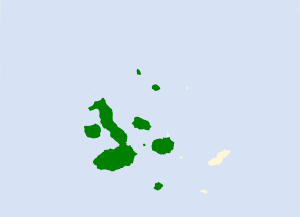Darwin's flycatcher facts for kids
Quick facts for kids Darwin's flycatcher |
|
|---|---|
 |
|
| Male | |
 |
|
| Female | |
| Conservation status | |
| Scientific classification | |
| Genus: |
Pyrocephalus
|
| Species: |
nanus
|
 |
|
| Synonyms | |
|
|
The Darwin's flycatcher or little vermilion flycatcher (Pyrocephalus nanus) is a small, colorful bird. It is a type of flycatcher, closely related to the vermilion flycatcher. This special bird lives only on the Galápagos Islands.
Sadly, the Darwin's flycatcher faces many of the same dangers that led to the San Cristóbal flycatcher's extinction. These threats include harmful animals like rats, which were brought to the islands by humans. You can find Darwin's flycatchers on the islands of Santa Cruz, Fernandina, Rabida, and Isabela. They live in damp forests and bushy areas. On average, they live for about five years.
Contents
About Darwin's Flycatcher
What is a Species?
In 1839, a scientist named John Gould first described Darwin's flycatcher. He called it Pyrocephalus nanus. Some bird experts, like the International Ornithologists' Union, believe it is its own unique species. A "species" is a group of living things that can have babies together.
However, other experts think it is a "subspecies" of the vermilion flycatcher. A "subspecies" is a group within a species that has small differences, often because they live in different places.
Conservation Status
The International Union for Conservation of Nature (IUCN) has listed Darwin's flycatcher as "vulnerable." This means it is at risk of becoming extinct. It has already disappeared from Floreana Island. It is also very close to disappearing from Santa Cruz island and is threatened on Isabela island.
In 2016, a big study on vermilion flycatchers changed how some birds were classified. This study decided that Darwin's flycatcher and the now-extinct San Cristóbal flycatcher should be considered their own species.
Hope for the Future
There is good news for these birds! In May 2023, conservation experts shared exciting news. They reported that 12 new chicks had been born that year on Santa Cruz Island. At that time, there were only 15 breeding pairs of these birds.
Danny Rueda, the director of the reserve, said that every chick born gives "new hope to save this species." He added that these 12 new birds are a "true success" since the program started in 2018.
What Darwin's Flycatchers Look Like
Male Darwin's flycatchers are very striking. They have bright red feathers on their bodies. Their wings and the markings around their eyes are black.
These birds are quite small. On average, they are about 13 centimeters (about 5 inches) long. They weigh about 12 grams (about 0.4 ounces). We don't know the largest size or weight they can reach.
See also
 In Spanish: Mosquero de Galápagos para niños
In Spanish: Mosquero de Galápagos para niños


